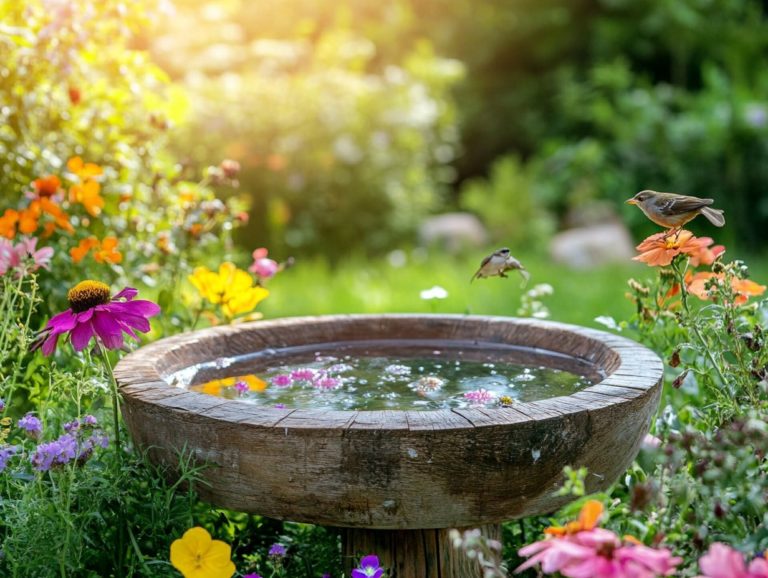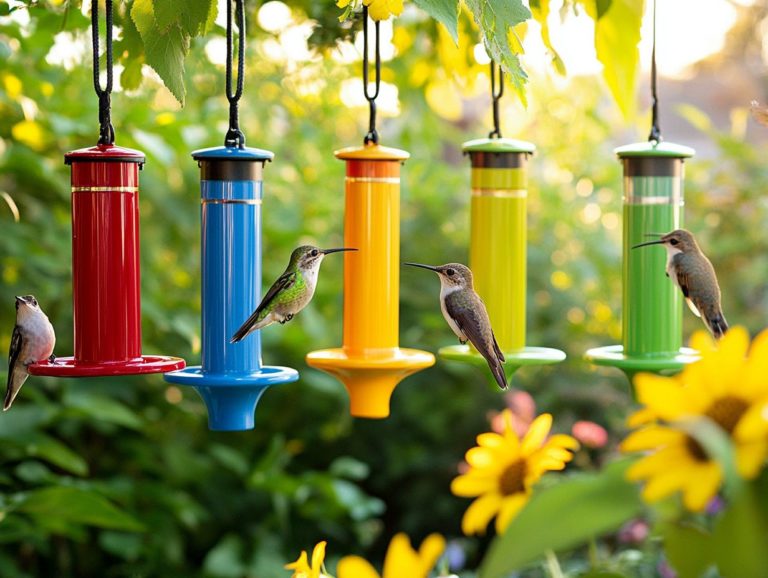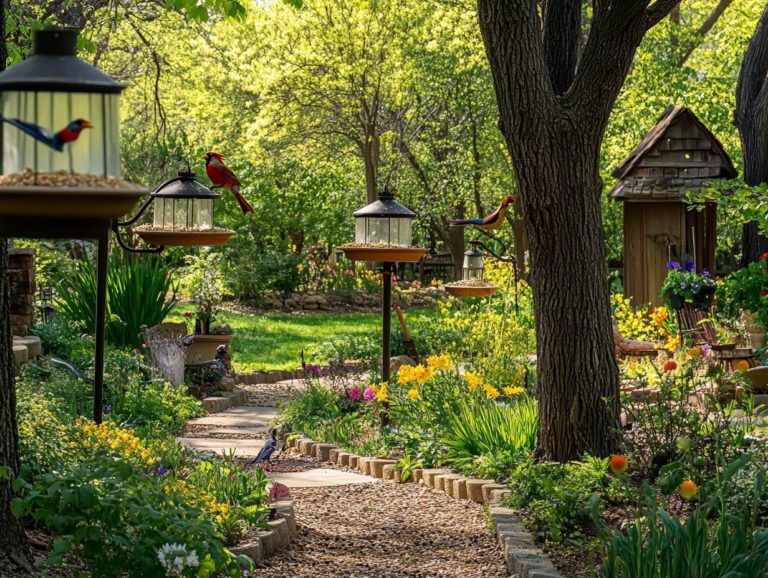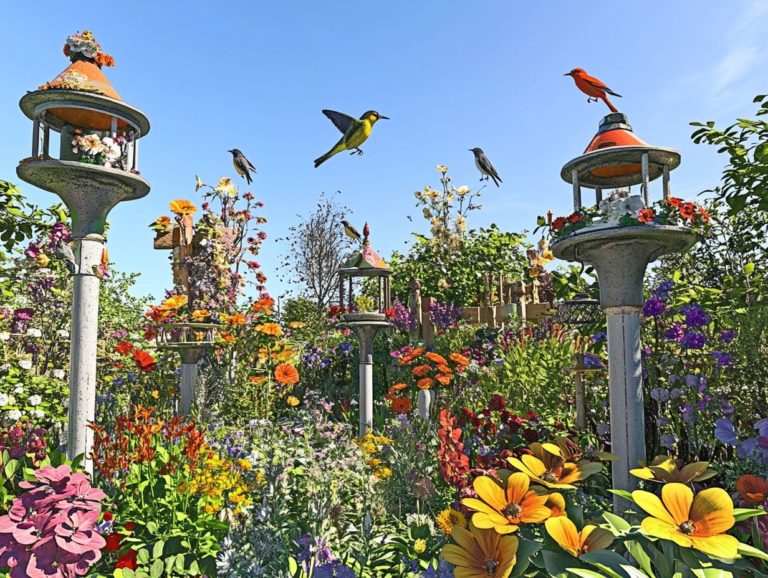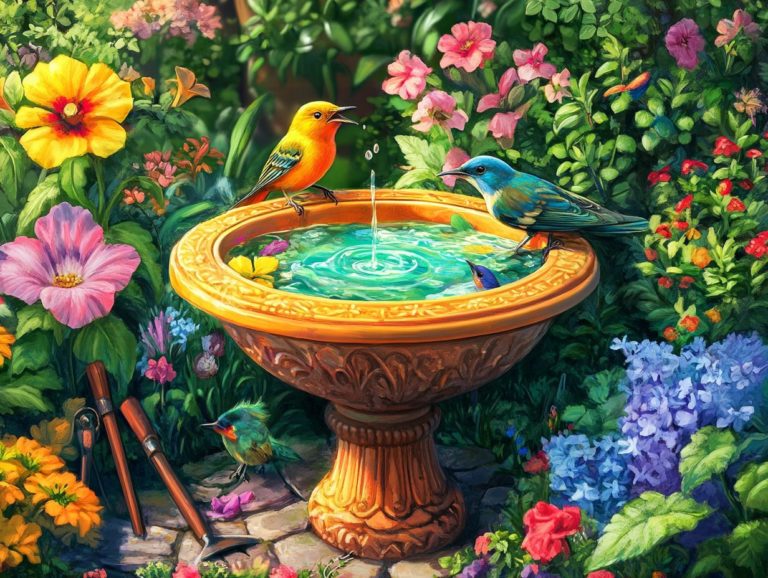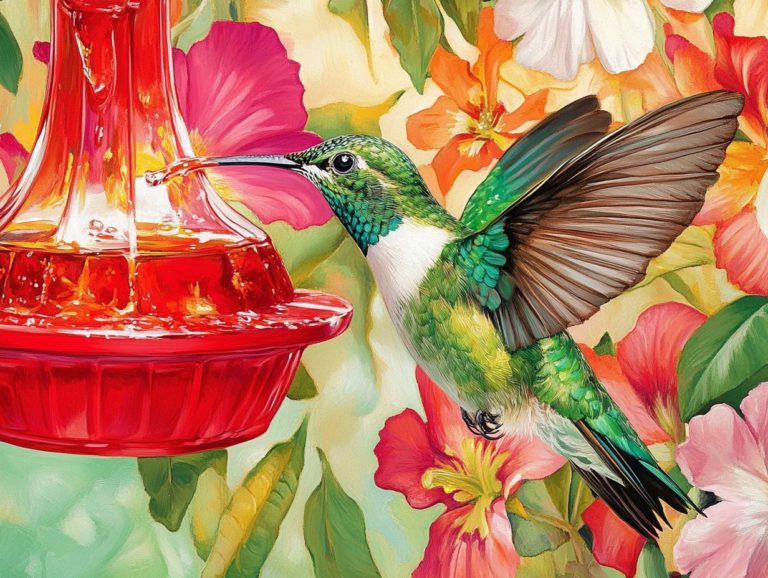5 Quick Tips for Bird Bath Maintenance
Bird baths can truly elevate your garden, transforming it into a vibrant haven where a variety of birds flock to enjoy the refreshing waters, infusing life into your outdoor space.
Maintaining your birdbath is crucial not just for the birds health but also for your own pleasure. From ensuring the water remains clear to selecting the ideal location, a bit of attention can yield remarkable results.
This article offers five succinct tips for effective birdbath maintenance, along with answers to common questions and challenges you may encounter.
Immerse yourself in these insights to keep your birdbath as a delightful oasis for your feathered friends!
Contents
Key Takeaways:
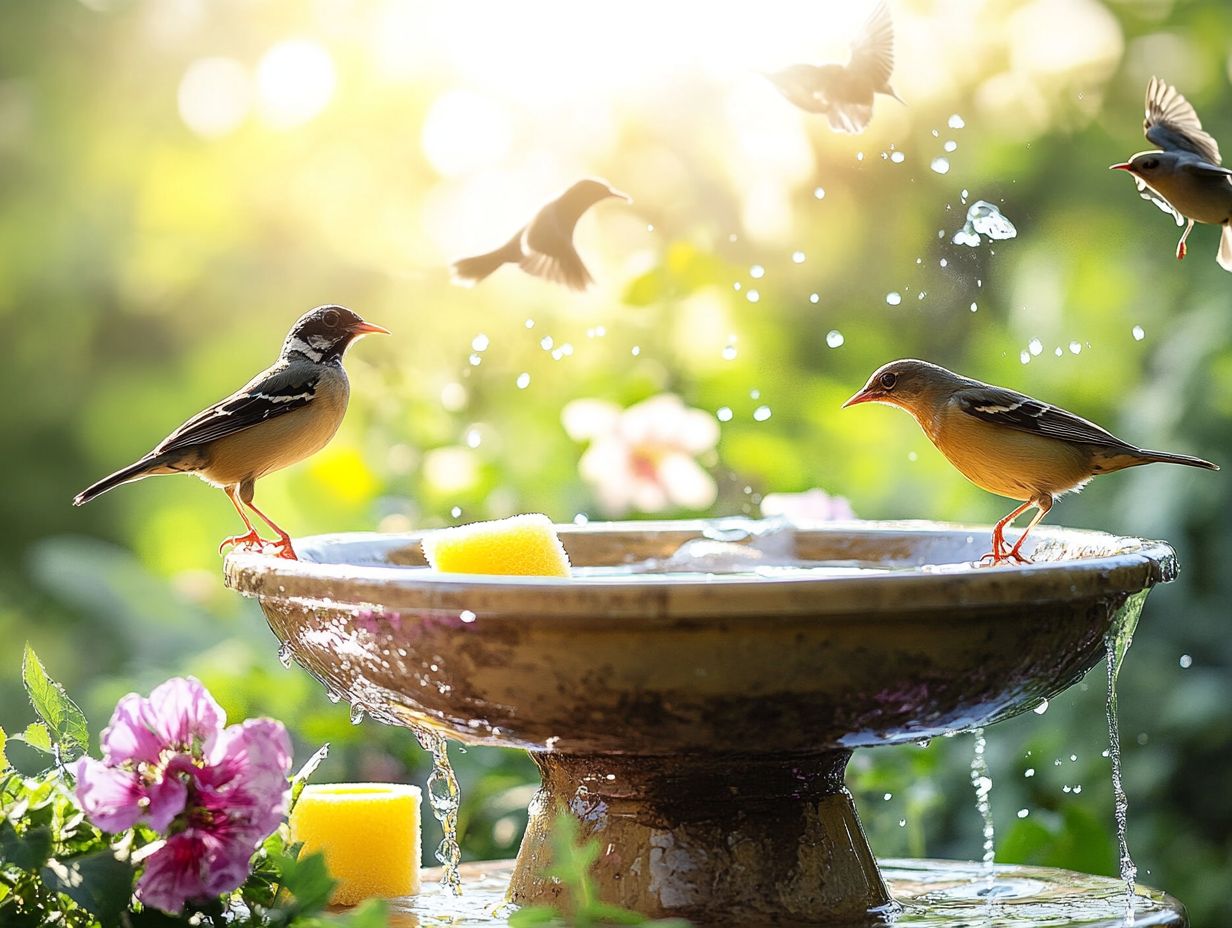
- Regular cleaning and changing of water is essential for a healthy birdbath.
- Algae and mineral deposits can be removed with a thorough scrubbing.
- Choosing the right location and providing nearby fresh water sources can attract more birds to your birdbath.
1. Keep It Clean
Maintaining a clean birdbath is essential for attracting a diverse array of backyard birds. Dirty water can harbor harmful bacteria like E. coli and pathogens such as Avian Flu, which pose serious risks to your feathered friends, as experts like Jolie Kerr emphasize.
Regular cleaning not only protects these birds but also enhances their presence in your garden, making birdwatching a delightful experience. To clean safely, consider using a simple mixture of vinegar and water; it disinfects effectively without harming the birds. A gentle scrub with a brush will help you remove algae and debris that tend to accumulate over time.
By ensuring your birdbath is consistently clean and fresh, you can significantly increase the chances of backyard birds returning to visit. This transforms a simple garden feature into a lively gathering spot, perfect for observation and appreciation.
2. Change the Water Regularly
To ensure your birdbath remains an inviting oasis for our feathered friends, it s essential to change the water regularly aim for every few days. This ensures clean and fresh water, preventing issues like evaporation.
In warmer climates, where higher temperatures can accelerate evaporation and encourage algae growth, you might find yourself needing to refresh the water more frequently sometimes even daily. In cooler areas, extending the interval slightly may be just fine.
No matter the temperature, providing fresh water is vital not only for hygiene, which helps reduce the risk of diseases, but also for attracting birds.
Birds are drawn to baths filled with clean, clear water, leading to lively bathing and drinking behaviors that can turn your garden into a vibrant tableau of nature s charm.
3. Scrub Away Algae and Mineral Deposits
Cleaning your birdbath regularly is essential to remove algae and mineral deposits, as these can make the water unattractive and unhealthy for birds. Opting for a suitable cleaning solution, such as vinegar, can be effective while preserving the natural habitat.
Additionally, a mixture of vinegar with water and dish soap works well as a gentle yet effective cleaning method. When scrubbing the bath, use a soft brush to avoid scratching the surface, which can provide a breeding ground for more algae. After scrubbing, rinse thoroughly to eliminate any soap residue.
Establishing a routine ideally once a week during warmer months ensures that birds always have a fresh and inviting source of hydration.
By keeping up with maintenance, you ll not only delight your feathered friends but also ensure your birdbath lasts for years of enjoyment!
4. Place the Bird Bath in the Right Location
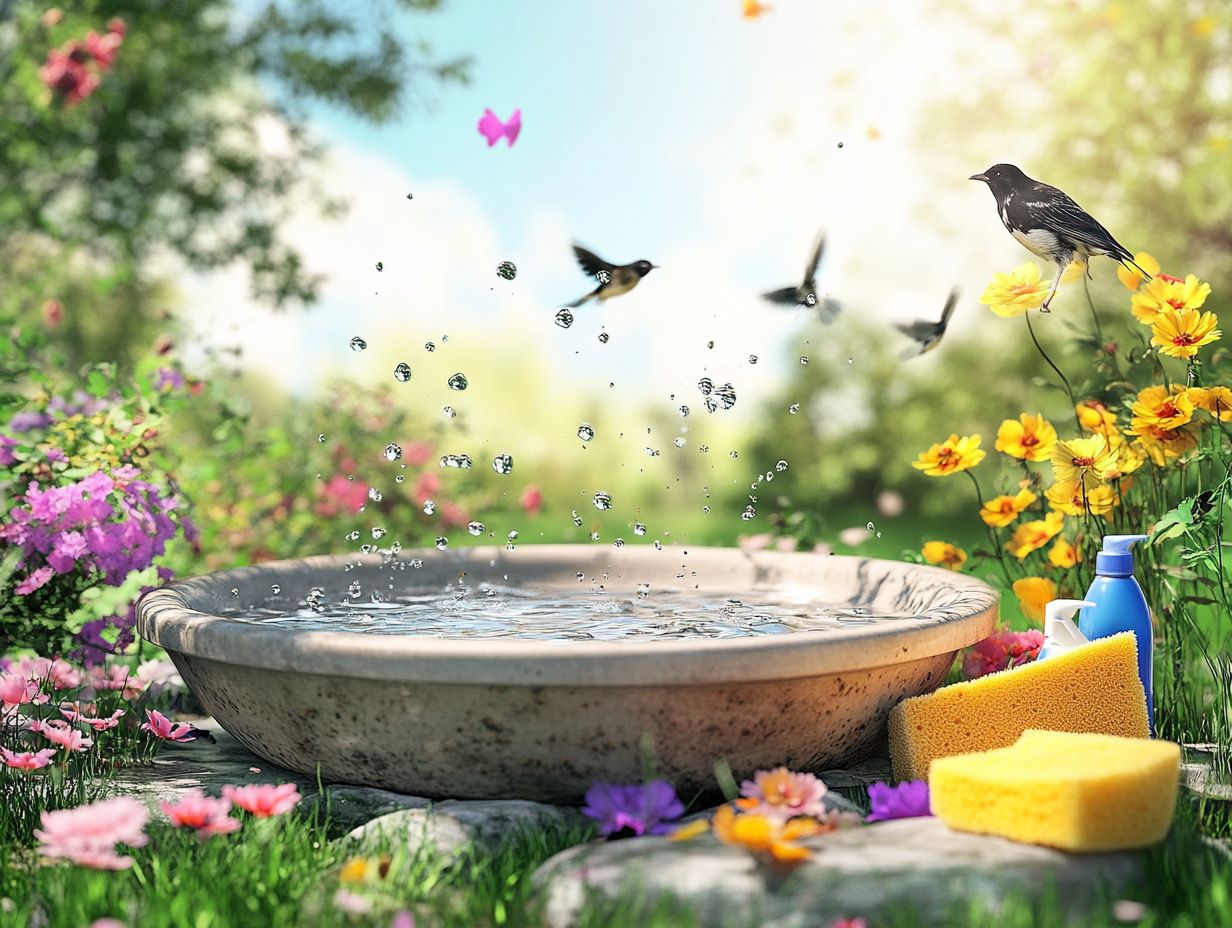
Choosing the right location for your bird bath is essential to attracting a variety of backyard birds. Aim for a shady spot that offers nearby places to sit, ensuring that the birds feel safe and secure during their visits.
Keep in mind the importance of sun exposure. Birds often prefer a warm spot when temperatures dip. They ll also seek out shade during the sweltering summer months. Nearby trees or shrubs can act as natural lookout posts, allowing birds to perch comfortably while they survey their surroundings for any potential threats.
Make sure your chosen location is free from predators like cats or birds of prey, as these can easily deter your feathered visitors. By thoughtfully selecting various locations, you ll enrich your birdwatching experience and open the door to observe a delightful range of species, especially during migration seasons when they flock to reliable water sources.
5. Provide Fresh Water Sources Nearby
To cultivate a flourishing habitat network for birds, it s essential to provide fresh water sources near your bird bath. This simple addition can make birds feel more at ease and encourage regular visits to your outdoor space.
Consider incorporating extra water features such as:
- Solar fountains
- Small ponds
- Shallow dishes
These diverse water sources not only offer hydration but also create vital spots for bathing, which are essential for maintaining healthy feathers. During migration, birds often struggle to find adequate resources, so having a variety of water options is crucial for attracting them.
The gentle sound of flowing water can draw birds from a distance, enhancing the appeal of your habitat and creating a welcoming environment for both resident and migratory species alike!
Why Is Bird Bath Maintenance Important?
Maintaining your bird bath is crucial, not just for the beauty of your backyard but also for fostering a vibrant habitat that attracts a variety of birds. By ensuring they have a clean and safe source of drinking water and a bathing area, you create an inviting space that requires regular care and attention.
When you prioritize cleanliness, you effectively thwart the spread of harmful bacteria and parasites that could jeopardize local bird populations. Refreshing the water regularly and scrubbing away algae not only promotes the health of your feathered friends but also elevates the visual allure of your outdoor sanctuary.
Your commitment to maintaining a welcoming environment can encourage a greater diversity of species to visit, enriching your birdwatching experiences. Ultimately, these simple yet significant practices play a vital role in supporting the local wildlife ecosystem, making every moment spent observing these captivating creatures all the more rewarding!
What Are the Common Problems with Bird Baths?
Common issues with bird baths include algae growth, water evaporation, and contamination with harmful bacteria like E. coli. These problems can deter birds from using the water feature and compromise their health.
These challenges primarily arise from insufficient maintenance and irregular cleaning, leading to an accumulation of organic matter such as fallen leaves and debris. Stagnant water becomes a breeding ground for bacteria and algae, creating an uninviting environment for visiting birds.
To avoid these issues, it’s crucial to change the water frequently—aim for at least once a week—and clean the bath with a gentle scrub to eliminate any buildup. Additionally, considering several factors when buying a bird bath, such as incorporating UV filters or a small water pump, can help keep the water fresh by reducing algae growth, enhancing the bath’s appeal, and supporting the health of the birds that rely on it.
Happy birdwatching!
How Often Should a Bird Bath Be Cleaned?
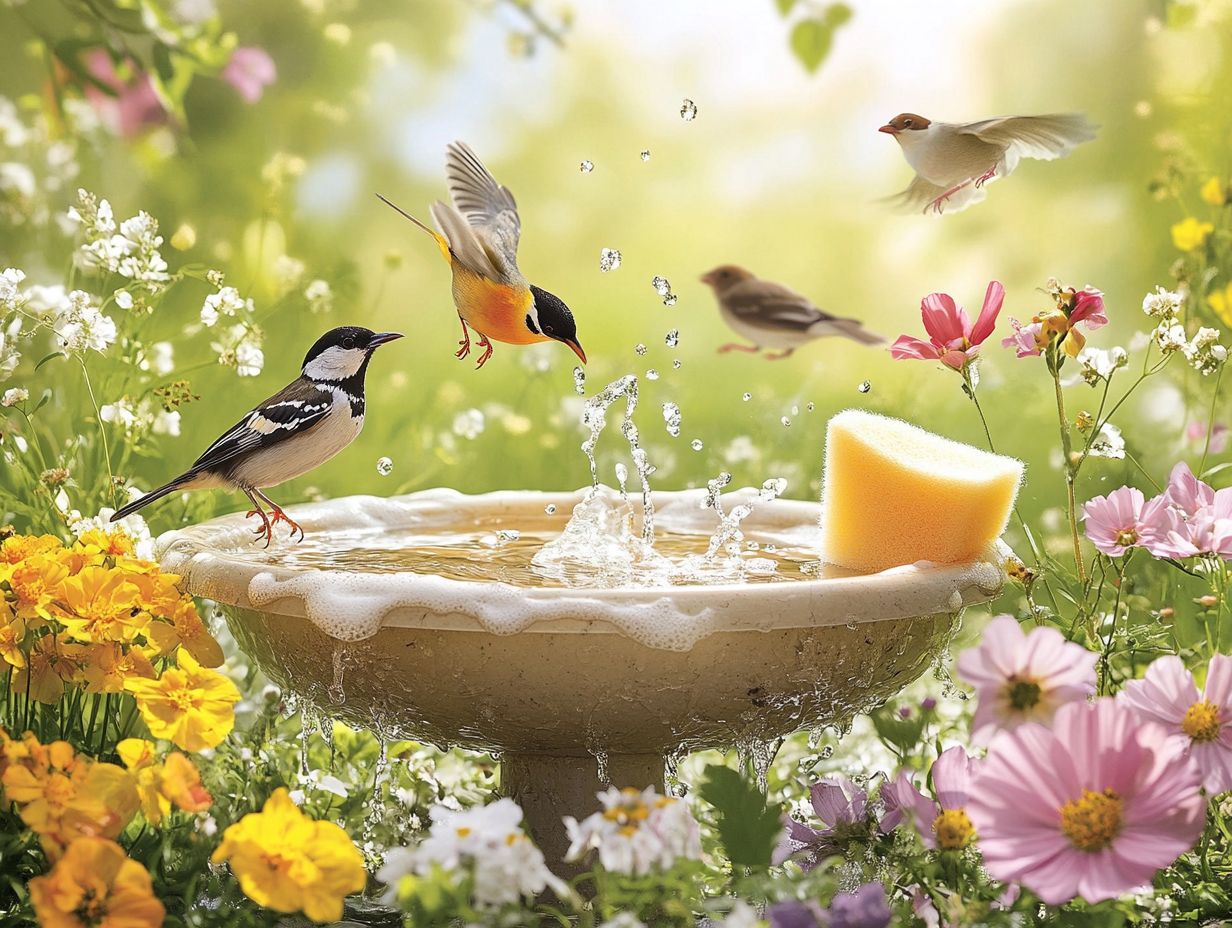
A bird bath deserves your attention at least once a week! You may want to clean it more often during hot spells or when your feathered friends are especially active.
How often you clean depends on your local conditions, such as the climate and the number of birds visiting. In warmer areas, green growth can appear in the water more quickly, requiring extra cleaning. If many birds visit your bath, debris can accumulate fast.
A smart cleaning routine could involve a thorough wash weekly and light rinsing every few days during peak activity.
To elevate the water quality, consider these practices:
- Regularly change the water
- Add a splash of vinegar as needed to prevent green growth
- Position the bath in a shady area to minimize sun exposure
What Are Some Alternative Methods for Cleaning a Bird Bath?
Alternative methods for cleaning a bird bath include using natural solutions like vinegar or safe commercial products. Avoid harsh chemicals such as chlorine bleach, as they can harm your feathered visitors and compromise water safety.
Besides vinegar, a simple mixture of baking soda and water can effectively tackle grime and odors while keeping your birds safe. Many bird lovers recognize the importance of a clean water source it attracts more birds and creates a secure environment.
By opting for eco-friendly options, you can help ensure harmful chemicals don t leach into the water, which is crucial for the health of these delightful creatures.
Natural remedies are often just as effective in eliminating green growth, bacteria, or other organic buildup, making them practical and responsible choices for maintaining your bird bath.
What Are Some Signs That a Bird Bath Needs Maintenance?
Signs that your bird bath requires maintenance include visible green growth, unpleasant odors, and water that appears murky or has significantly evaporated, indicating it’s time for a thorough cleaning.
If you overlook these signs, you risk creating an unsuitable habitat for your feathered friends, which may discourage them from visiting. Regular inspections are essential for maintaining a clean and inviting environment.
When assessing the condition of the bird bath, examine the water quality. It should be clear and free of any odors. Check the basin for debris, leaves, or dead insects that could harbor harmful bacteria.
It s wise to scrub the surface with a brush, and replacing the water every few days will make it more appealing to local birds, encouraging them to visit frequently.
How Can One Prevent Algae and Mineral Buildup in a Bird Bath?
Preventing green growth and mineral buildup in a bird bath is all about adopting a proactive approach. Regular cleaning, selecting the right location to minimize sunlight exposure, and using products designed to inhibit green growth are key strategies.
Position your bird bath in a sheltered area that enjoys partial shade. After all, direct sunlight can lead to rapid algae growth. Keeping the water quality pristine is essential changing the water every few days significantly reduces the chances of buildup.
To streamline your efforts, invest in a brush with soft bristles and scrub the bath weekly. Pair this with an eco-friendly cleaning solution that effectively targets green growth without risking harm to your feathered friends.
For added efficiency, consider installing a filtration system a device that helps keep the water clean ensuring a safe haven for your avian companions.
Frequently Asked Questions
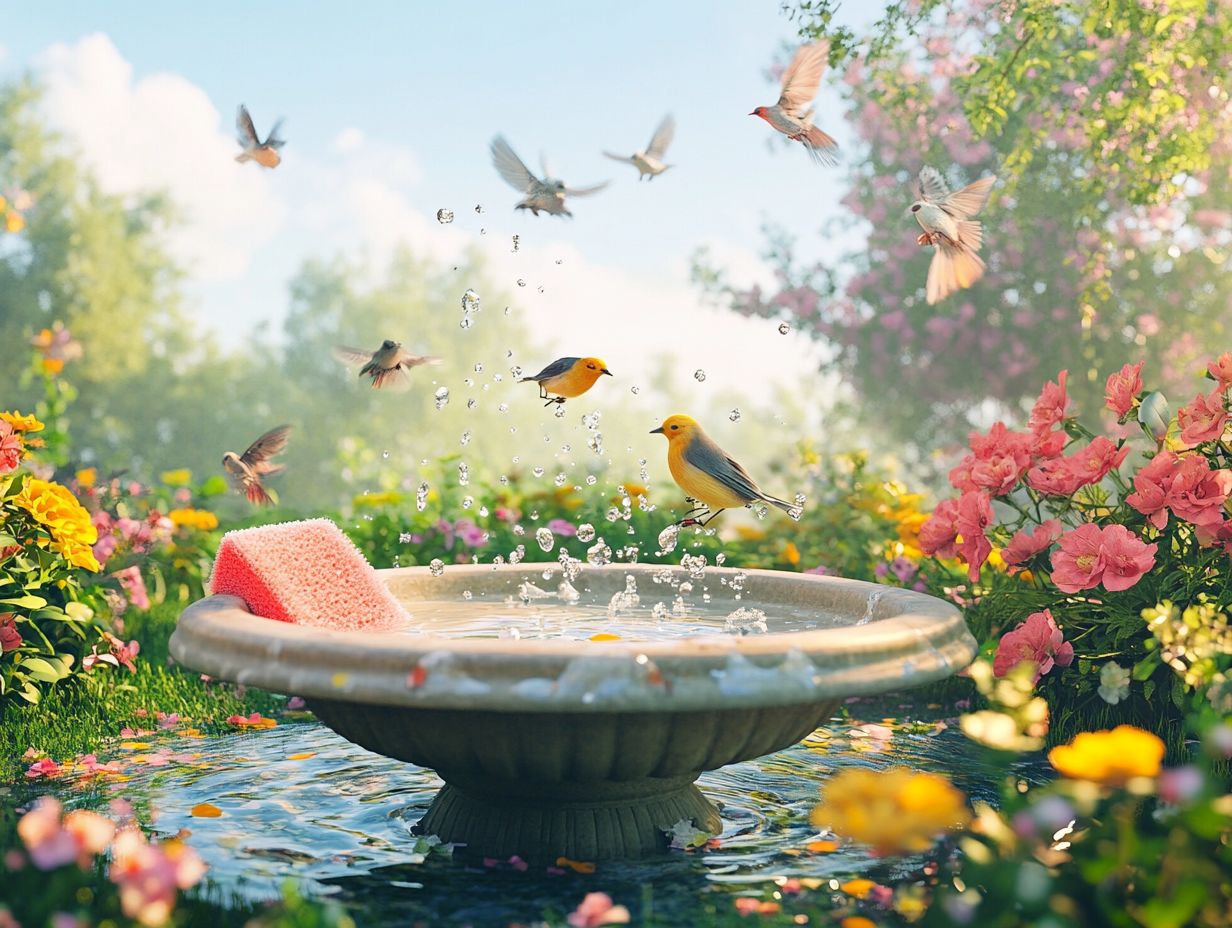
What are 5 quick tips for bird bath maintenance?
1. Keep the bird bath clean. Clean it often using a bird-safe cleaner.
2. Change the water at least once a week to prevent bacteria and algae growth.
3. Place the bird bath in a shaded area to keep the water cool and reduce evaporation.
4. Install a bird bath heater in winter to provide birds with water during freezing temperatures.
5. Add a few smooth stones in the bird bath to give birds a place to perch and help prevent slipping. You might also consider some stylish bird baths that enhance your garden for added charm.
What can happen if I neglect my bird bath?
If neglected, a bird bath can become a breeding ground for harmful bacteria and algae. Dirty water may also attract mosquitoes and other insects, posing health risks to birds.
Can I use regular cleaning products to clean my bird bath?
No, always use a bird-safe cleaning solution. Regular products may contain harmful chemicals for birds.
Can I leave my bird bath out during winter?
Yes, you can leave it out, but remember to change the water regularly and use a bird bath heater to prevent freezing.
How often should I refill my bird bath?
Refill your bird bath weekly to keep birds coming! If the water becomes dirty, change it immediately.
Can I use any type of water in my bird bath?
No, always use clean, fresh water for happy, healthy birds! Avoid softened or distilled water, as it may contain harmful chemicals.

